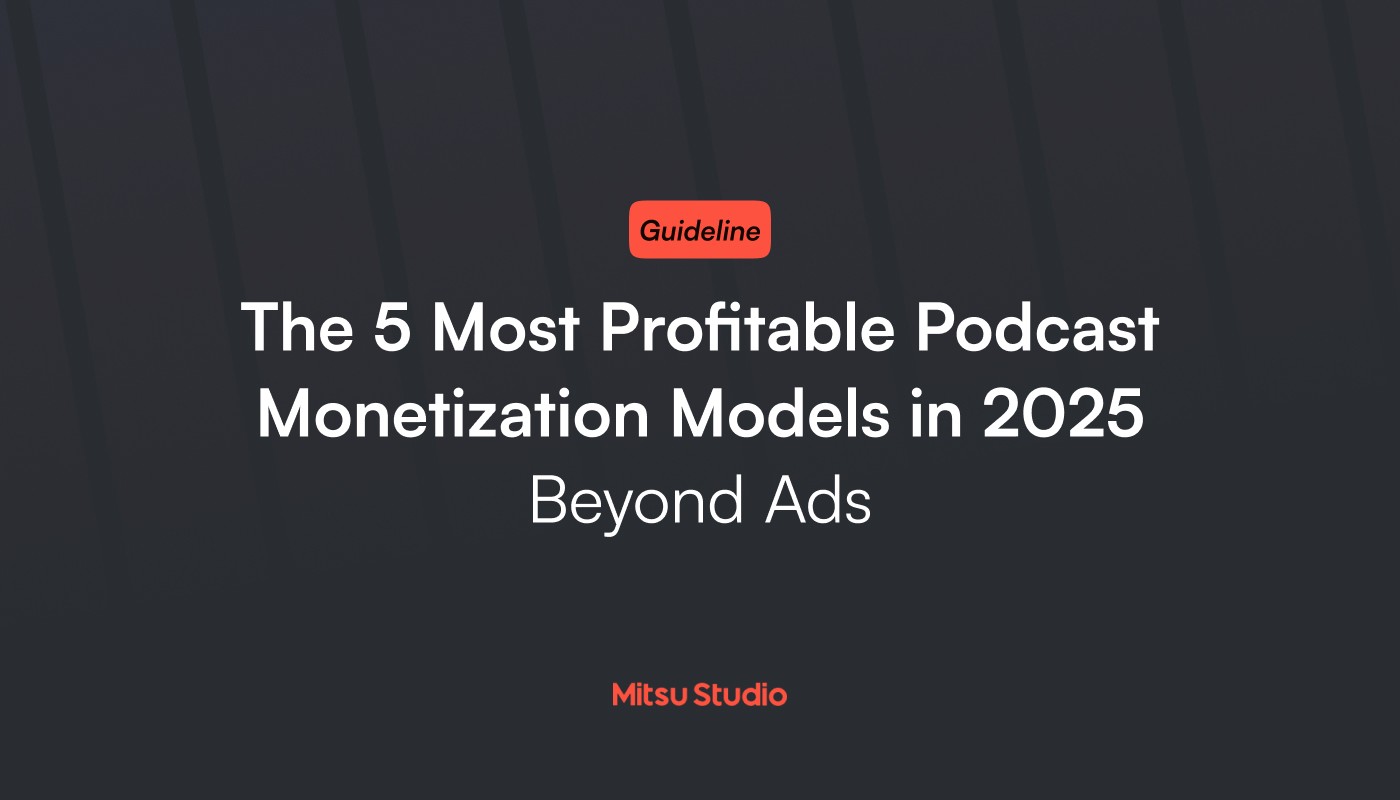May 20, 2025
In today's saturated podcasting landscape, relying solely on traditional advertising may limit revenue potential. While ad revenue remains significant—U.S. podcast ad spending is projected to reach $2.38 billion in 2025 —savvy podcasters are diversifying their income streams to build more sustainable businesses. This article explores five profitable podcast monetization models that are complementing traditional advertising in 2025.
1. Direct Listener Support: The Loyalty Model
Direct listener support has evolved beyond simple donations, becoming a cornerstone of podcast monetization.
Effective Strategies:
Tiered Membership Programs: Offering multiple support levels (e.g., $5–$25/month) with escalating benefits encourages more listeners to contribute.
Transparency & Connection: Podcasts that openly share their goals and progress foster a sense of community and investment among listeners.
Exclusive Communities: Providing access to private forums or community platforms enhances listener engagement and retention.
Case Study: "The History Underground"
This mid-sized history podcast, with approximately 85,000 monthly listeners, generates significant monthly revenue through its membership program. Their tiered approach includes:
$5: Ad-free episodes and extended content
$10: Bonus episodes and community access
$25: Exclusive interviews and merchandise discounts
By focusing on community-building and offering valuable perks, they have achieved high retention rates among supporters.
2. Premium Content Subscriptions: The Value-Add Model
Offering premium content subscriptions allows podcasters to provide additional value to dedicated listeners.
Effective Strategies:
Feed Separation: Keeping main episodes free while offering premium content on specialized topics encourages subscriptions.
Platform-Native Subscriptions: Utilizing native subscription systems on platforms like Apple Podcasts and Spotify can improve conversion rates due to reduced friction.
Content Bundling: Including downloadable resources (e.g., guides, templates) alongside premium audio enhances perceived value.
Case Study: "Growth Stack" Business Podcast
This startup-focused podcast, with 120,000 monthly listeners, earns substantial monthly revenue through its premium subscription model. Their approach includes:
Free weekly episodes on broad business concepts
$9.99/month premium feed featuring in-depth interviews and tactical episodes
Access to a document library with relevant resources
Their conversion rate from listener to subscriber is notably higher than industry averages, reflecting the value provided to subscribers.
3. Live Events & Experiences: The Connection Model
Hosting virtual and in-person events has become a significant revenue driver, offering deeper connections with audiences.
Effective Strategies:
Hybrid Events: Combining in-person experiences with virtual access can increase revenue compared to single-format events.
Exclusive Access Events: Limited-seat workshops and masterclasses, priced appropriately, often sell out quickly and receive high satisfaction ratings.
Brand Partnerships for Events: Securing sponsors for events can enhance profit margins without increasing ticket prices.
Case Study: "Mind/Matter" Psychology Podcast
With 175,000 monthly listeners, this psychology podcast generates significant revenue per quarterly event through a hybrid model:
200 in-person tickets at $175 each
Unlimited virtual attendance at $45 per ticket
Event sponsors covering production costs
Post-event content package sold separately
Their strategic pricing and hybrid approach maximize reach and revenue.
4. Physical & Digital Products: The Merchandise Model
Expanding beyond traditional merchandise, successful podcasters create products that integrate into listeners' lifestyles.
Effective Strategies:
Lifestyle Integration Products: Items like mugs, journals, and phone accessories that fit into daily routines often outperform standard logo apparel.
Limited Edition Drops: Time-limited merchandise releases can generate more revenue due to scarcity marketing.
Digital Product Expansions: Offering digital versions of expertise (e.g., courses, templates) can yield higher profit margins than physical products.
Case Study: "Trail Tales" Outdoor Podcast
This hiking and outdoor adventure podcast, with 95,000 monthly listeners, earns significant monthly revenue through its merchandise strategy:
Quarterly limited-edition product drops featuring outdoor gear
A digital "Trail Guide Library" with downloadable resources
Collaborations with outdoor brands on co-branded products
Their approach extends the brand experience and addresses audience needs effectively.
5. Strategic Brand Partnerships: The Alignment Model
Forming deeper, more integrated brand relationships can lead to increased revenue beyond standard ad placements.
Effective Strategies:
Brand Integration Series: Multi-episode partnerships with natural brand integration can yield higher fees than standard ads.
Co-Created Content: Brands sponsoring entire series or segments developed around their expertise are willing to pay premium rates.
Exclusivity Premiums: Category exclusivity deals can command higher rates by preventing podcasters from working with competing brands.
Case Study: "Future Finance" Podcast
This personal finance podcast, with 150,000 monthly listeners, generates substantial monthly revenue through strategic partnerships:
Quarter-long exclusive partnerships with financial services companies
Co-created "deep dive" bonus episodes sponsored by a single brand
Branded segments within regular episodes focused on specific financial topics
Their partnership-focused model yields an effective CPM significantly higher than standard podcast advertising rates.
The Multi-Stream Approach: Why Diversification Wins
The most financially successful podcasts in 2025 aren't relying on a single revenue stream. Diversifying income sources provides greater stability and resilience.
Key Insights:
Utilizing multiple monetization strategies can mitigate risks associated with seasonal advertiser fluctuations.
Diversified revenue correlates more strongly with audience growth than content frequency alone.
Getting Started: Your Action Plan
Ready to move beyond basic advertising? Consider these steps:
Audience Assessment: Survey your listeners to understand their preferences and willingness to support different models.
Start Small: Begin with one alternative monetization stream before expanding.
Test & Iterate: Implement, measure results, gather feedback, and refine your approach.
Community First: Prioritize building community engagement before monetization.
Value Exchange: Ensure every monetization method provides clear, tangible value to your audience.
Conclusion
While traditional advertising remains important, the most resilient and profitable podcasts in 2025 are those embracing diverse monetization strategies. By thoughtfully implementing these models, you can build a more sustainable podcast business while deepening connections with your audience.
Note: The case studies presented are illustrative and based on industry trends and practices.



